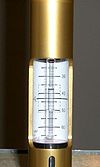Inserting NMR Sample
Adjusting sample depth with a sample gauge
First, the NMR tube is needed to be inserted into a spinner turbine. For best results, NMR tubes should be positioned in the spinner turbine in such a way that the sample remains centered in the r.f. coil region inside the NMR probe. This can be done with the help of a sample gauge, which usually has a center line and rectangular markings to indicate the probe geometry.
A sample gauge also has an adjustable bottom, which can be adjusted to allow quick positioning of a series of identical samples. Setting a sample tube too low may cause it to break, as well as contaminate and damage the probe!
It is also important to make sure that the tube sits firmly in the spinner. If your sample slides too easily inside a spinner turbine, it may indicate that the rubber o-rings of the spinner need replacement.
Inserting and ejecting
To access the Insert and Eject buttons do the following:
- VNMR - click on the Acqi button or type acqi
- VNMRJ - click on the Setup tab
You can also type insert or i and eject or e at the command prompt in VNMR or VNMRJ.
Sample change procedure
- Eject the current sample first. Even if there is no sample in the magnet you need to use eject to create the upward thrust using the airflow.
- Remove the ejected sample.
- Place the sample in the spinner in the bore. Verify that you have the airflow to support your sample while still holding the sample. Leave the sample.
- Click on Insert to lower your sample.
Avoid leaving the spectrometer with an open bore for long periods of time, as this increases the risk of contamination of the bore with foreign particles. If you need to remove a sample and have nothing else to measure, either insert a standard NMR sample or cover the bore with a dedicated plug.
External links
http://www.varianinc.com/image/vimage/docs/products/nmr/apps/pubs/manuals/0199916100c.pdf
http://www.varianinc.com/image/vimage/docs/products/nmr/apps/pubs/manuals/0199931300b.pdf
Working with Bruker Instruments
As with Varians, the sample tube is loaded into a spinner and the depth is adjusted using a depth gauge. The base of the depth gauge should be set to the minimum sample tube depth allowed by the probe in use. DO NOT adjust this level. The minimum volume depth for most Bruker probes is normally smaller than that for Varians, as a result it is important to use Shigemi tubes suitable for use with Bruker probes (they will have a shorter glass base).
Samples are manually ejected and inserted into the magnet using the sample eject/insert button on the BSMS panel; the button is located in the top left corner of the BSMS. Samples can also be ejected using the command line in Topspin (command, ej).
The procedure for inserting the NMR sample into the magnet is analogous to Varians:
- Eject the current sample. Pressing the eject button on the BSMS (green light comes on) will initiate an upward airflow and the current sample will float to the top of the bore.
- Replace the current sample with the new sample.
- Pressing the eject button again on the BSMS (green light turns off) stops the airflow and the sample is slowly lowered into the magnet.
- Look for the sample lock to ensure the sample is properly sitting in the probe.
